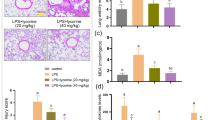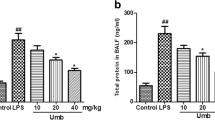Abstract
Exposure to bacterial endotoxins, such as lipopolysaccharide (LPS), can lead to the induction of acute lung injury/acute respiratory distress syndrome (ALI/ARDS). To date, there are no known effective treatments for LPS-induced inflammation. In the current study, we investigated the potential use of the hyaluronic acid (HA) synthesis inhibitor 4-methylumbelliferone (4-MU) on LPS-induced acute lung inflammation. Culturing LPS-activated immune cells with 4-MU led to reduced proliferation, reduced cytokine production, and an increase in apoptosis when compared to untreated cells. Treatment of mice with 4-MU led to protection from LPS-induced lung injury. Specifically, 4-MU treatment led to a reduction in LPS-induced hyaluronic acid synthase (HAS) messenger RNA (mRNA) levels, reduction in lung permeability, and reduction in proinflammatory cytokine production. Taken together, these results suggest that use of 4-MU to target HA production may be an effective treatment for the inflammatory response following exposure to LPS.






Similar content being viewed by others
References
Bhatia, M., and S. Moochhala. 2004. Role of inflammatory mediators in the pathophysiology of acute respiratory distress syndrome. The Journal of Pathology 202: 145–156.
Rubenfeld, G.D., E. Caldwell, E. Peabody, J. Weaver, D.P. Martin, M. Neff, et al. 2005. Incidence and outcomes of acute lung injury. The New England Journal of Medicine 353: 1685–1693.
Rubenfeld, G.D., and M.S. Herridge. 2007. Epidemiology and outcomes of acute lung injury. Chest 131: 554–562.
Shafeeq, H., and I. Lat 2012. Pharmacotherapy for acute respiratory distress syndrome. Pharmacotherapy. 32:943–57. doi:10.1002/j.1875-9114.2012.01115.
Bao, A., L. Liang, F. Li, M. Zhang, and X. Zhou. 2013. Consequences of acute ozone exposure imposed on the culminated allergic pulmonary inflammation in an established murine model of asthma. Frontiers in Bioscience 18: 838–851.
Liang, J., D. Jiang, Y. Jung, T. Xie, J. Ingram, T. Church, et al. 2011. Role of hyaluronan and hyaluronan-binding proteins in human asthma. The Journal of Allergy and Clinical Immunology 128: 403–411. e3.
Yoon, J.S., H.J. Lee, S.H. Choi, E.J. Chang, S.Y. Lee, and E.J. Lee. 2011. Quercetin inhibits IL-1beta-induced inflammation, hyaluronan production and adipogenesis in orbital fibroblasts from Graves’ orbitopathy. PloS One 6: e26261.
Campo, G.M., A. Avenoso, S. Campo, A. D’Ascola, G. Nastasi, and A. Calatroni. 2010. Small hyaluronan oligosaccharides induce inflammation by engaging both toll-like-4 and CD44 receptors in human chondrocytes. Biochemical Pharmacology 80: 480–490.
Ernst, G., S. Lompardia, R. Cordo Russo, V. Gentilini, S. Venturiello, F. Galindez, et al. 2012. Corticosteroid administration reduces the concentration of hyaluronan in bronchoalveolar lavage in a murine model of eosinophilic airway inflammation. Inflammation Research 61: 1309–1317.
Esser, P.R., U. Wolfle, C. Durr, F.D. von Loewenich, C.M. Schempp, M.A. Freudenberg, et al. 2012. Contact sensitizers induce skin inflammation via ROS production and hyaluronic acid degradation. PloS One 7: e41340.
Stern, R., A.A. Asari, and K.N. Sugahara. 2006. Hyaluronan fragments: An information-rich system. European Journal of Cell Biology 85: 699–715.
Baeva, L.F., D.B. Lyle, M. Rios, J.J. Langone, and M.M. Lightfoote. 2014. Different molecular weight hyaluronic acid effects on human macrophage interleukin 1beta production. Journal of Biomedical Materials Research. Part A 102: 305–314.
Sokolowska, M., L.Y. Chen, M. Eberlein, A. Martinez-Anton, Y. Liu, S. Alsaaty, et al. 2014. Low molecular weight hyaluronan activates cytosolic phospholipase A2alpha and eicosanoid production in monocytes and macrophages. The Journal of Biological Chemistry 289: 4470–4488.
Bollyky, P.L., J.D. Lord, S.A. Masewicz, S.P. Evanko, J.H. Buckner, T.N. Wight, et al. 2007. Cutting edge: High molecular weight hyaluronan promotes the suppressive effects of CD4+ CD25+ regulatory T cells. Journal of Immunology 179: 744–747.
Mohamadzadeh, M., H. DeGrendele, H. Arizpe, P. Estess, and M. Siegelman. 1998. Proinflammatory stimuli regulate endothelial hyaluronan expression and CD44/HA-dependent primary adhesion. The Journal of Clinical Investigation 101: 97–108.
Singleton, P.A., T. Mirzapoiazova, Y. Guo, S. Sammani, N. Mambetsariev, F.E. Lennon, et al. 2010. High-molecular-weight hyaluronan is a novel inhibitor of pulmonary vascular leakiness. American Journal of Physiology. Lung Cellular and Molecular Physiology 299: L639–L651.
Asari, A., T. Kanemitsu, and H. Kurihara. 2010. Oral administration of high molecular weight hyaluronan (900 kDa) controls immune system via Toll-like receptor 4 in the intestinal epithelium. The Journal of Biological Chemistry 285: 24751–24758.
Uchakina, O.N., C.M. Castillejo, C.C. Bridges, and R.J. McKallip. 2013. The role of hyaluronic acid in SEB-induced acute lung inflammation. Clinical Immunology 146: 56–69.
Uchakina, O.N., H. Ban, and R.J. McKallip 2013. Targeting hyaluronic acid production for the treatment of leukemia: Treatment with 4-methylumbelliferone leads to induction of MAPK-mediated apoptosis in K562 leukemia. Leukemia Research. 1294–301. doi:10.1016/j.leukres.2013.07.009.
Sun, J., G.P. Law, C.C. Bridges, and R.J. McKallip. 2012. CD44 as a novel target for treatment of staphylococcal enterotoxin B-induced acute inflammatory lung injury. Clinical Immunology 144: 41–52.
Udaka, K. 1970. Proceedings of the Society for Experimental Biology and Medicine 133: 1384.
Lokeshwar, V.B., L.E. Lopez, D. Munoz, A. Chi, S.P. Shirodkar, S.D. Lokeshwar, et al. 2010. Antitumor activity of hyaluronic acid synthesis inhibitor 4-methylumbelliferone in prostate cancer cells. Cancer Research 70: 2613–2623.
McKallip, R.J., H.F. Hagele, and O.N. Uchakina. 2013. Treatment with the hyaluronic acid synthesis inhibitor 4-methylumbelliferone suppresses SEB-induced lung inflammation. Toxins (Basel) 5: 1814–1826.
Urakawa, H., Y. Nishida, J. Wasa, E. Arai, L. Zhuo, K. Kimata, et al. 2012. Inhibition of hyaluronan synthesis in breast cancer cells by 4-methylumbelliferone suppresses tumorigenicity in vitro and metastatic lesions of bone in vivo. International Journal of Cancer 130: 454–466.
Arai, E., Y. Nishida, J. Wasa, H. Urakawa, L. Zhuo, K. Kimata, et al. 2011. Inhibition of hyaluronan retention by 4-methylumbelliferone suppresses osteosarcoma cells in vitro and lung metastasis in vivo. British Journal of Cancer 105: 1839–1849.
Edward, M., J.A. Quinn, S.M. Pasonen-Seppanen, B.A. McCann, and R.H. Tammi. 2010. 4-Methylumbelliferone inhibits tumour cell growth and the activation of stromal hyaluronan synthesis by melanoma cell-derived factors. The British Journal of Dermatology 162: 1224–1232.
Piccioni, F., M. Malvicini, M.G. Garcia, A. Rodriguez, C. Atorrasagasti, N. Kippes, et al. 2012. Antitumor effects of hyaluronic acid inhibitor 4-methylumbelliferone in an orthotopic hepatocellular carcinoma model in mice. Glycobiology 22: 400–410.
McKallip, R.J., Y. Do, M.T. Fisher, J.L. Robertson, P.S. Nagarkatti, and M. Nagarkatti. 2002. Role of CD44 in activation-induced cell death: CD44-deficient mice exhibit enhanced T cell response to conventional and superantigens. International Immunology 14: 1015–1026.
Itano, N., T. Sawai, M. Yoshida, P. Lenas, Y. Yamada, M. Imagawa, et al. 1999. Three isoforms of mammalian hyaluronan synthases have distinct enzymatic properties. The Journal of Biological Chemistry 274: 25085–25092.
Doi, K., A. Leelahavanichkul, P.S. Yuen, and R.A. Star. 2009. Animal models of sepsis and sepsis-induced kidney injury. The Journal of Clinical Investigation 119: 2868–2878.
Goodman, R.B., J. Pugin, J.S. Lee, and M.A. Matthay. 2003. Cytokine-mediated inflammation in acute lung injury. Cytokine & Growth Factor Reviews 14: 523–535.
Nakazawa, H., S. Yoshihara, D. Kudo, H. Morohashi, I. Kakizaki, A. Kon, et al. 2006. 4-methylumbelliferone, a hyaluronan synthase suppressor, enhances the anticancer activity of gemcitabine in human pancreatic cancer cells. Cancer Chemotherapy and Pharmacology 57: 165–170.
Campo, G.M., A. Avenoso, S. Campo, A. D’Ascola, P. Traina, C.A. Rugolo, et al. 2010. Differential effect of molecular mass hyaluronan on lipopolysaccharide-induced damage in chondrocytes. Innate Immunity 16: 48–63.
Pauloin, T., M. Dutot, F. Joly, J.M. Warnet, and P. Rat. 2009. High molecular weight hyaluronan decreases UVB-induced apoptosis and inflammation in human epithelial corneal cells. Molecular Vision 15: 577–583.
Ruffell, B., and P. Johnson. 2008. Hyaluronan induces cell death in activated T cells through CD44. Journal of Immunology 181: 7044–7054.
Kultti, A., S. Pasonen-Seppanen, M. Jauhiainen, K.J. Rilla, R. Karna, E. Pyoria, et al. 2009. 4-Methylumbelliferone inhibits hyaluronan synthesis by depletion of cellular UDP-glucuronic acid and downregulation of hyaluronan synthase 2 and 3. Experimental Cell Research 315: 1914–1923.
Daines, D.A., J. Sun, O.N. Uchakina, and R.J. McKallip 2013. Development of a novel treatment for leukemia directed at tumor-associated mRNA splicing. Leukemia Research. 1125–31. doi:10.1016/j.leukres.2013.06.017.
Yoshida, M., N. Itano, Y. Yamada, and K. Kimata. 2000. In vitro synthesis of hyaluronan by a single protein derived from mouse HAS1 gene and characterization of amino acid residues essential for the activity. The Journal of Biological Chemistry 275: 497–506.
Bollyky, P.L., R.P. Wu, B.A. Falk, J.D. Lord, S.A. Long, A. Preisinger, et al. 2011. ECM components guide IL-10 producing regulatory T-cell (TR1) induction from effector memory T-cell precursors. Proceedings of the National Academy of Sciences of the United States of America 108: 7938–7943.
Jiang, D., J. Liang, J. Fan, S. Yu, S. Chen, Y. Luo, et al. 2005. Regulation of lung injury and repair by Toll-like receptors and hyaluronan. Nature Medicine 11: 1173–1179.
Jiang, D., J. Liang, and P.W. Noble. 2011. Hyaluronan as an immune regulator in human diseases. Physiological Reviews 91: 221–264.
Teder, P., R.W. Vandivier, D. Jiang, J. Liang, L. Cohn, E. Pure, et al. 2002. Resolution of lung inflammation by CD44. Science 296: 155–158.
Bollyky, P.L., B.A. Falk, R.P. Wu, J.H. Buckner, T.N. Wight, and G.T. Nepom. 2009. Intact extracellular matrix and the maintenance of immune tolerance: High molecular weight hyaluronan promotes persistence of induced CD4+ CD25+ regulatory T cells. Journal of Leukocyte Biology 86: 567–572.
Conflict of Interest
The authors have no conflict of interest.
Author information
Authors and Affiliations
Corresponding author
Rights and permissions
About this article
Cite this article
McKallip, R.J., Ban, H. & Uchakina, O.N. Treatment with the Hyaluronic Acid Synthesis Inhibitor 4-Methylumbelliferone Suppresses LPS-Induced Lung Inflammation. Inflammation 38, 1250–1259 (2015). https://doi.org/10.1007/s10753-014-0092-y
Published:
Issue Date:
DOI: https://doi.org/10.1007/s10753-014-0092-y




